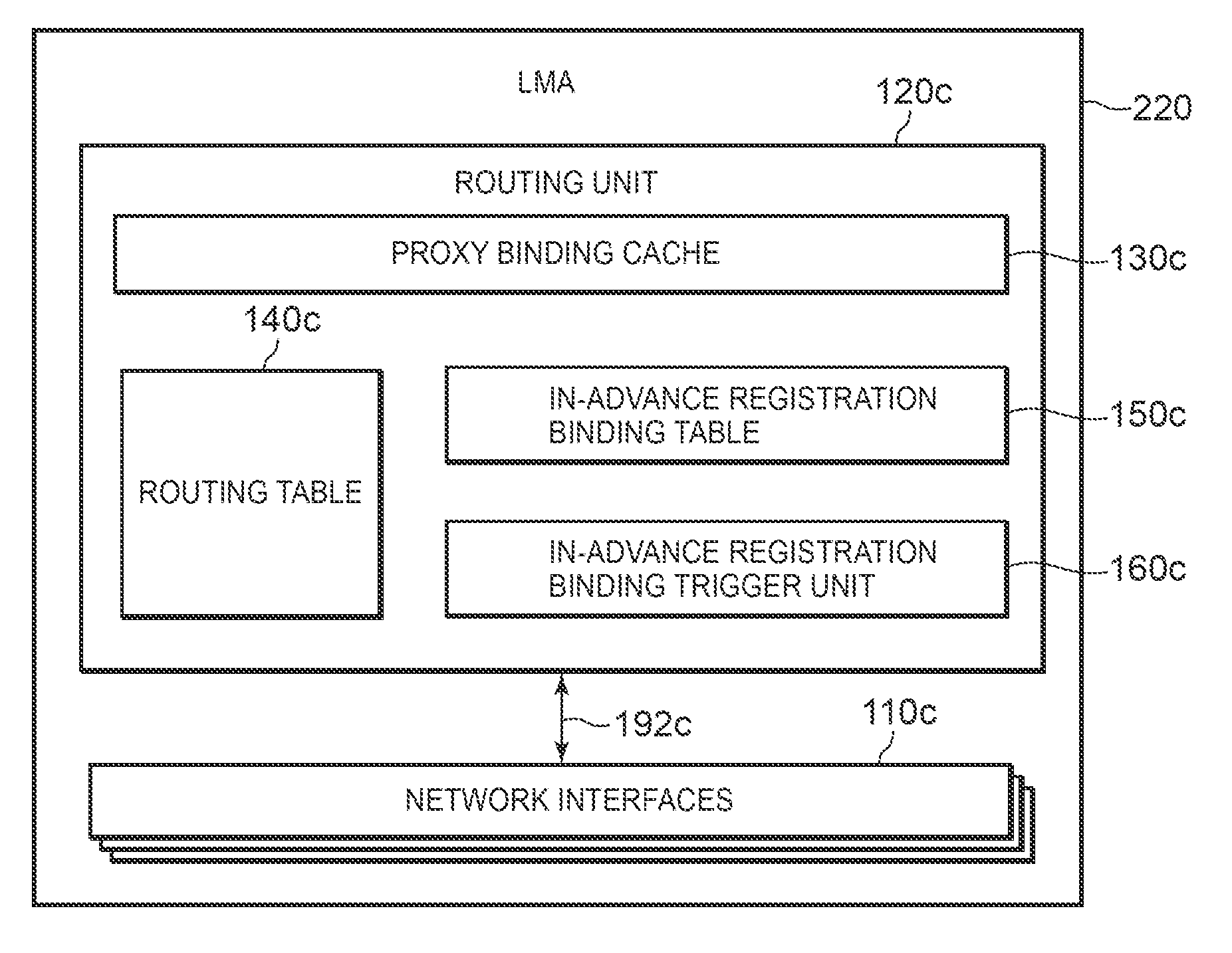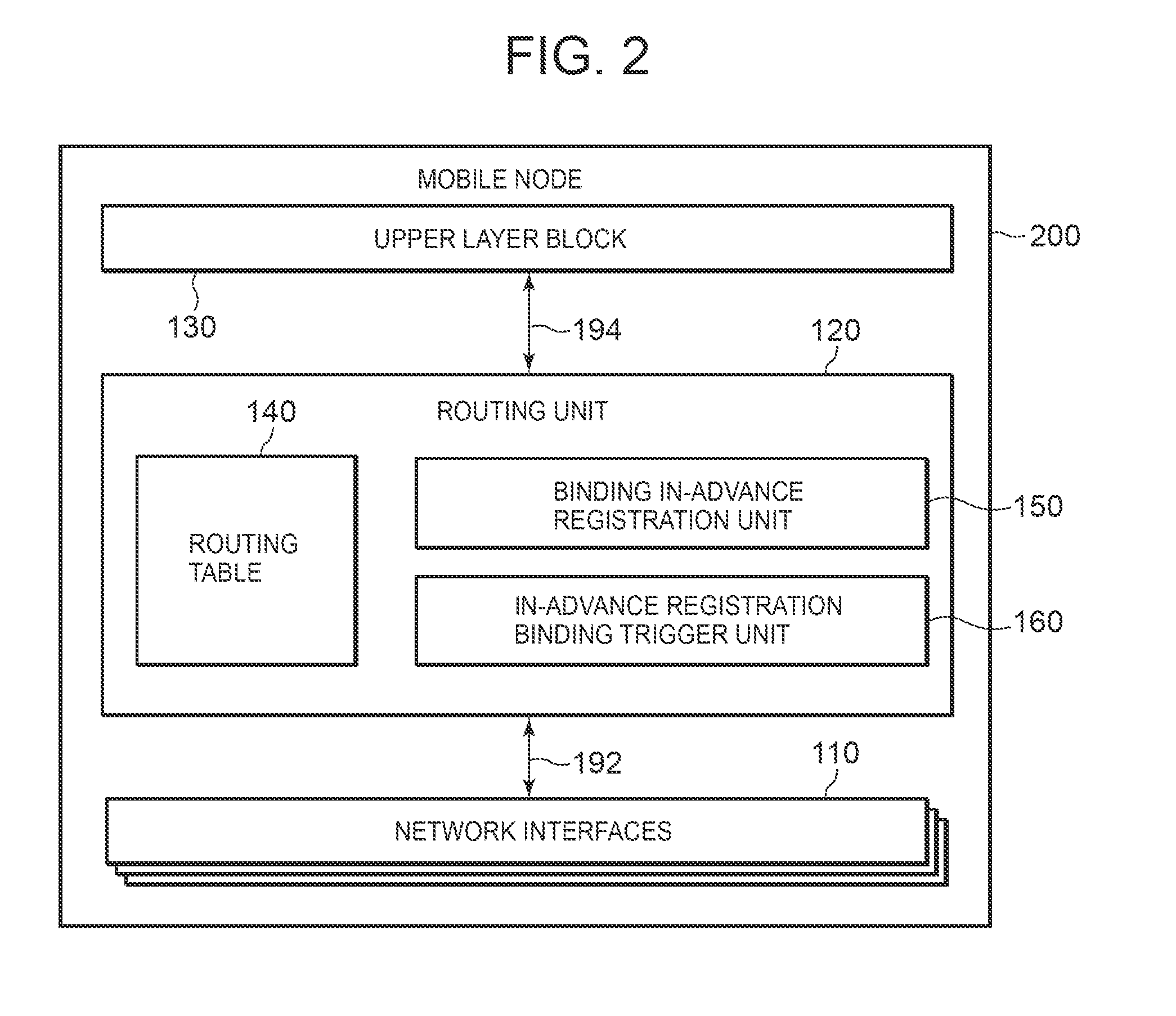Interface Switching System, Mobile Node, Proxy Node, and Mobile Management Node
- Summary
- Abstract
- Description
- Claims
- Application Information
AI Technical Summary
Benefits of technology
Problems solved by technology
Method used
Image
Examples
first embodiment
[0114]FIG. 5 shows a communication sequence according to a first embodiment. First, the MN 200 is communicating (connected) with the MAG(WLAN) 232. Therefore, a PBU message 301 has already been transmitted from the MAG(WLAN) 232 to the LMA 220, and binding related to the WLAN connection 242 is already registered in the LMA 220. When an interface switching event 300 is generated during communication with the MAG(WLAN) 232, the MN 200 transmits to the MAG(WLAN) 232 via the WLAN connection 242, a binding in-advance registration message 302 to register in advance a binding registration related to the cellular connection 240. Examples of the interface switching event 300 include one or more of: when signal strength of the WLAN connection 242 drops below a predetermined threshold; when loss of the WLAN connection 242 is predicted by detection of the moving speed of the MN 200; and when the MN 200 has started a real-time communication session via the WLAN connection 242 and desires minimal...
second embodiment
[0124]FIG. 8 shows a communication sequence according to a second embodiment. The MN 200 is communicating (connected) with the MAG(WLAN) 232. Therefore, the PBU message 301 has already been transmitted from the MAG(WLAN) 232 to the LMA 220, and the binding related to the WLAN connection 242 is already registered in the LMA 220. When an interface switching event 300 is generated during communication with the MAG(WLAN) 232, the MN 200 transmits the binding in-advance registration message 302 to the MAG(WLAN) 232 via the WLAN connection 242, the MN 200 transmits the binding in-advance registration message 302 to the MAG(WLAN) 232 via the WLAN connection 242. The binding in-advance registration message 302 includes the desire of the MN 200 to establish the cellular connection 240 in place of the current WLAN connection 242 binding. The interface switching events and the method of identifying the replacement cellular connection 240 are similar to those according to the first embodiment. ...
third embodiment
Changing Binding Destination
[0135]Ordinarily, the mobile node binds an unstable connection to a stable connection as the in-advance registration binding. Because the connection of the binding destination (the interface to which the interface is switched) is stable, the connection of the binding destination is rarely changed before the in-advance binding is activated. However, an instance such as the following can be considered. FIG. 11 shows another system postulated in the present invention. In FIG. 11, a cellular access type MAG(3GPP) 430 is added to the configuration shown in FIG. 1.
[0136]FIG. 12 shows a communication sequence in FIG. 11, and includes a procedure for handing off the cellular connection 240 between the MN 200 and the MAG(3GPP) 230 to a new cellular connection 440 between the MN 200 and the MAG(3GPP) 430. The PBU message 301, the interface switching event 300, the binding in-advance registration message 302, the transfer message 304, and the response message 306 in...
PUM
 Login to View More
Login to View More Abstract
Description
Claims
Application Information
 Login to View More
Login to View More - R&D
- Intellectual Property
- Life Sciences
- Materials
- Tech Scout
- Unparalleled Data Quality
- Higher Quality Content
- 60% Fewer Hallucinations
Browse by: Latest US Patents, China's latest patents, Technical Efficacy Thesaurus, Application Domain, Technology Topic, Popular Technical Reports.
© 2025 PatSnap. All rights reserved.Legal|Privacy policy|Modern Slavery Act Transparency Statement|Sitemap|About US| Contact US: help@patsnap.com



